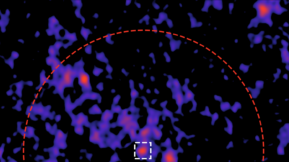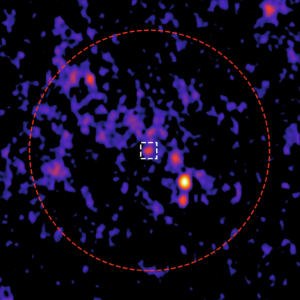Mysterious radio source in heart of ancient star cluster might be a rare black hole
If true, this could mark an astronomy breakthrough.

One of the Milky Way's brightest globular clusters is emanating mysterious radio waves from its heart, new observations have revealed. Scientists believe the intriguing signal may be produced by a medium-sized black hole; if true, that'd make this result the first of its kind.
The team discovered the signal while scanning the 47 Tucanae cluster with the Australia Telescope Compact Array (ATCA) in New South Wales. Globular clusters are ancient groupings of stars scattered around the Milky Way galaxy. Stars inside these clusters are packed much more densely than those in other parts of the galaxy. 47 Tucanae, for example, contains more than a million stars in a sphere with a diameter of 120 light-years. This cluster is the second brightest in the sky and can even be observed with the naked eye.
But with 450 hours of radio measurements with ATCA, researchers from the International Centre for Radio Astronomy Research (ICRAR) created the most detailed radio image of 47 Tucanae ever achieved. And in the very center of the cluster, located some 14,500 light-years from the sun, they found the unusual radio wave source.
The researchers think the signal must be produced either by a medium-sized black hole or a pulsar, which is a fast-spinning neutron star that emits radio waves. Both objects would be intriguing, but a discovery of a medium-sized black hole would present a breakthrough.
Related: New mystery object could be lightest black hole ever seen

Medium-sized black holes are the missing link between stellar black holes left over from the deaths of giant stars and supermassive black holes — enormous monsters sitting at the centers of galaxies that can be as massive as millions, or even billions, of suns. Astrophysicists speculate that supermassive black holes must have grown from the gradual merging of smaller black holes, however, they have not seen much evidence of this process in the universe.
"While intermediate-mass black holes are thought to exist in globular clusters, there hasn’t been a clear detection of one yet," Alessandro Paduano, lead author of the study and a former Ph.D. student at Curtin University in Perth, Australia, said in an emailed statement. "If this signal turns out to be a black hole, it would be a highly significant discovery and the first-ever radio detection of one inside a cluster."
Get the Space.com Newsletter
Breaking space news, the latest updates on rocket launches, skywatching events and more!
The ATCA image of 47 Tucanae is as detailed as highly anticipated images that'll be obtained by the Square Kilometer Array Observatory (SKAO) will be, the researchers said. SKAO, currently being built on sites in Western Australia and South Africa consists of thousands of sensitive radio antennas. Once completed later this decade, the array will be the most sensitive radio telescope in the world.
"This project has stretched our software to its limits, in terms of both data management and processing, and it has been really exciting to see the wealth of science that these techniques have enabled," Tim Galvin, a research scientist at CSIRO and co-author of a paper on the study, said in the statement. "Alessandro's research represents a culmination of years of research and technological advancements, and ATCA's ultra-deep image of 47 Tucanae represents just the beginning of the discoveries that are yet to come."
Arash Bahramian, an astronomer at Curtin Institute of Radio Astronomy who oversaw the project, added: "We managed to achieve close to SKA-quality science with the current generation of radio telescopes, combining hundreds of hours of observations to reveal the faintest details. It gives us a glimpse of the exciting capabilities the next generation of radio telescopes will achieve when they come online."
In the future, the technique could be used to amplify the power of SKAO to help astronomers detect the faintest objects in the universe.
The study was published on Jan. 15 in The Astrophysical Journal.
Join our Space Forums to keep talking space on the latest missions, night sky and more! And if you have a news tip, correction or comment, let us know at: community@space.com.

Tereza is a London-based science and technology journalist, aspiring fiction writer and amateur gymnast. Originally from Prague, the Czech Republic, she spent the first seven years of her career working as a reporter, script-writer and presenter for various TV programmes of the Czech Public Service Television. She later took a career break to pursue further education and added a Master's in Science from the International Space University, France, to her Bachelor's in Journalism and Master's in Cultural Anthropology from Prague's Charles University. She worked as a reporter at the Engineering and Technology magazine, freelanced for a range of publications including Live Science, Space.com, Professional Engineering, Via Satellite and Space News and served as a maternity cover science editor at the European Space Agency.









